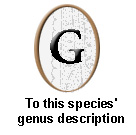


|
SEM Photo Gallery- Maryland specimens Photo Gallery- Pakistan specimens Molecular Diagnostics |
Adult females
Adult females are swollen, lemon-shaped and pearly-white in colour
with a distinctly protruded vulva, a thin cuticle (7.9 um) thickest
at the neck-body junction, with a zigzag external pattern anteriorly, but
appearing wavy around the vulval cone with broken transverse lines interspersed
with longitudinal lines. The head has two annules, the second larger
than the first. The stylet is slender with fairly developed anteriorly
flattened knobs. It has a long neck and a large rounded median bulb,
with well-developed valve plates. The excretory pore is placed posterior
to the head tip and is at the level of oesophageal gland lobe. The
oesophageal gland is in a single lobe and is variable in size and shape.
Two ovaries are present. The mature females are filled with eggs
in various stages of development. The vulval cone is well developed
with a fairly long vulval slit. The anus is very small, indistinct
and placed close to the vulva. An egg sac is present which is generally
small but is in some cases one third to one half of the body length.
Most of the eggs are retained in the body and only a few in the egg sac.
Cysts
The cyst is lemon-shaped, with protruding neck and vulva. It
is light-brown in colour, thin walled and without a subcrystalline layer.
The cyst wall pattern on the body proper is in the form of a zig-zag pattern.
The vulval cone is prominent. The end-on view of the vulval cone
shows concentric lines of cuticular ridges around the vulval slit and fenestra.
Fenestrae are ambifenestrate with the two semifenestrae separated by a
vulval bridge and surrounded by a wide 'basin'. The anus is indistinct.
Bullae are present, the characteristic arrangement for H. zeae including
four finger-like bullae in a distinct formation immediately below the underbridge.
The underbridge is simple, short and thin, and is found in all but a few
of the cysts examined. Immediately below the finger-like bullae are
a number of randomized bullae. The vulval slit is fairly long.
Second-stage juveniles
The second-stage juveniles are vermiform and cylindrical, tapering
at both ends. The head has 4-5 annules, with a moderately developed
cephalic framework. The stylet is slender with slightly anteriorly
directed knobs. According to Koshy et al. (1971) the length of stylet
was about 20-25 um (23.0 + 0.26 um), whilst Golden
and Mulvey (1983) reported that larval stylets from India and Maryland,
USA, were continuously found to average about 20.0 um. The
dorsal oesophageal gland opens close (4-5 um) to the base of the
stylet. There is a distinct median valve with well developed valve
plates. The basal part of the oesophagus extends as a glandular lobe overlapping
the anterior region of the intestine, mostly laterally and dorsally.
The hemizonid is distinct, located closer to the excretory pore and is
1-2 annules in length. The anus is distinct. Phasmids are small
but conspicuous. The lateral field has four lines. The tail
is short, hyaline and terminal with an acutely rounded terminus.
Mulvey and Golden (1983) compared two isolates- their measurements
are as follows:
H. zeae
|
|
|
|
|
|
|
|
|
|
(360-440) |
|
(20-25) |
(32-50) |
(16-30) |
(4-5) |
|
|
(399-460) |
|
(19-20.7) |
(40-49) |
(16.8 - 25.2) |
(3.4-5) |
Eggs
The egg shell is hyaline, without cuticular markings. According
to Koshy et al. (1971), the majority of eggs measure about 105 -110 um
in length and 35-38 um in width. Measurements given by Golden and
Mulvey (1983) include length 97-105 um (102.6 + 2.1 um)
and width 37.8 - 47.2 um (43.3 + 2.6 um).
Males
The males of H. zeae are very rare and detailed descriptions
were made for the first time by Hutzell (1984) from a culture originating
from cysts collected in Kent, Maryland, at the site of the first known
infestation in the USA.
(Description- CABI Crop Protection Compendium CD-Rom 2000)
 |
 |
 |